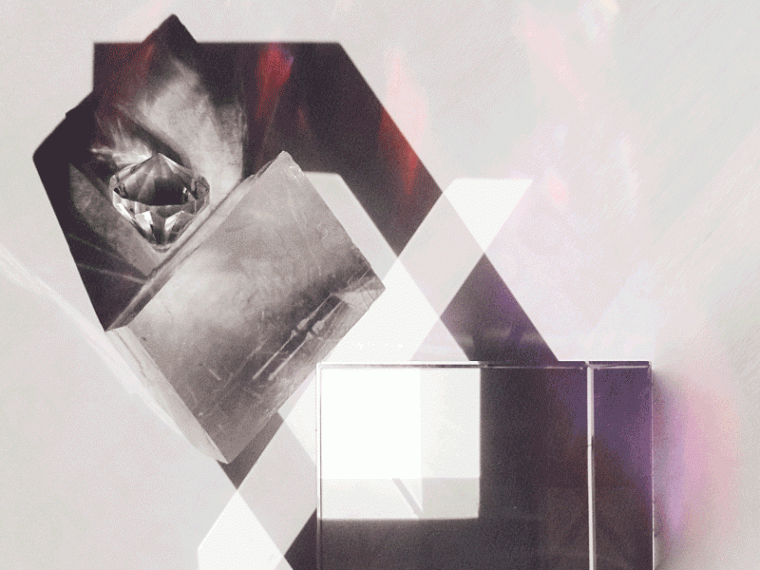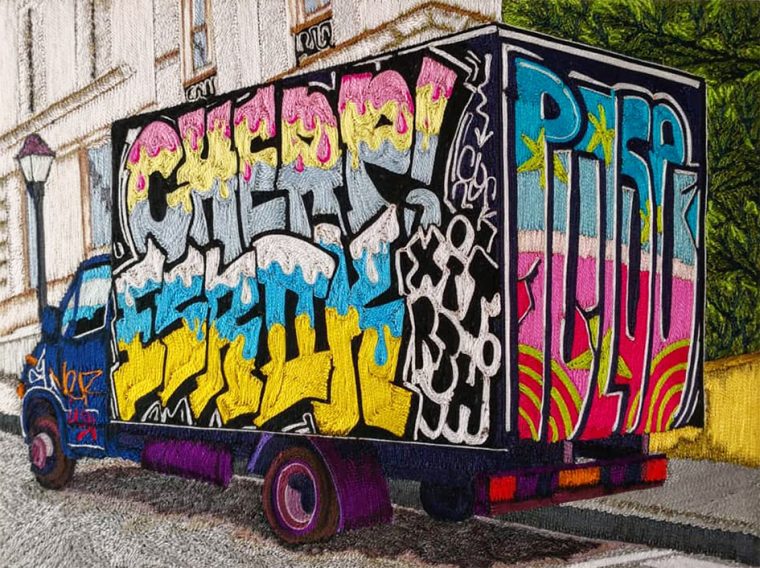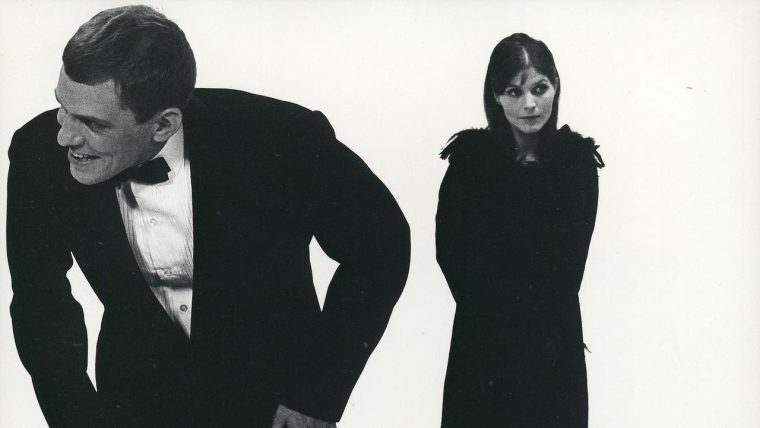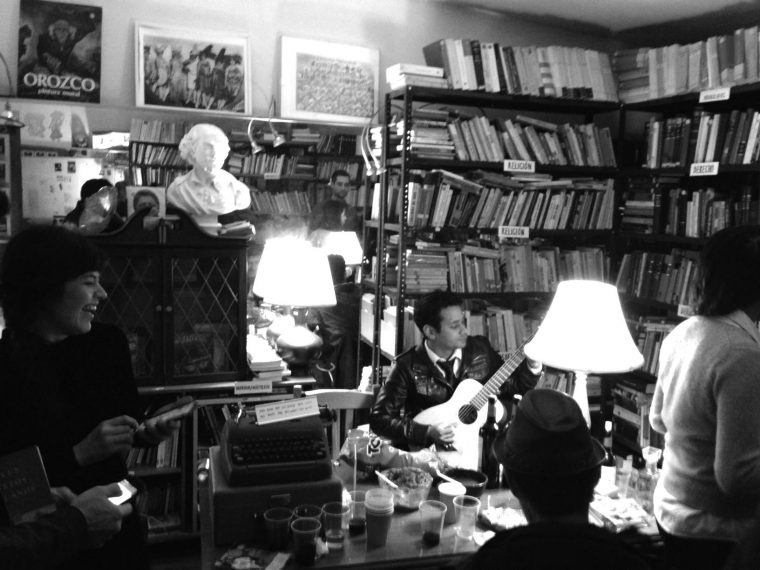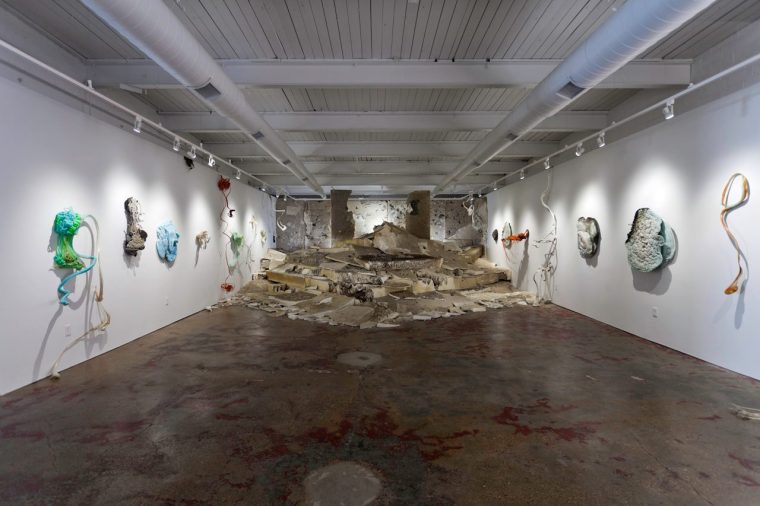Laura Ortiz Vega:No USA return
For her debut solo exhibition at Tube Factory Art Space, Laura Ortiz Vega presents a new series of “thread paintings” inspired by the rhetoric surrounding President Trump’s proposed US-Mexico border wall.
Vega takes as her departure point the now famous images of the eight border wall samples President Trump browsed in 2017 as they were being tested along the actual border between San Diego and Tijuana. Listening to the speeches Trump has given about the wall, and reading his tweets on the subject, Vega then extracted the eight adjectives the President most frequently used to describe the project.
GREAT, BIGGEST, IMPENETRABLE, PHYSICAL, TALL, POWERFUL, BEAUTIFUL, INCREDIBLE
Each word an imposing declaration; each wall sample an impenetrable facade.
Seizing the chance to subvert public perception of these messages, Vega presents the adjectives like graffiti on the border wall samples, turning each section of wall into a billboard advertising its own hyperbolically alleged attributes.
Says Vega, “I saw the opportunity to present this matter in a positive note. I envisioned the wall as a blank canvas for expression, and in a way, made him eat his own words. [It is] a chance to reject the negativity and turn this around.”
Vega models her distinctive thread painting method after the traditional craft techniques of the indigenous Huichol people of western Mexico. She first covers a surface with cera de Campeche, a natural beeswax from the Mexican state of Campeche. She then “draws” on that surface with cotton Perlé embroidery thread, using a palette knife to embed the thread into the wax. It is a long, delicate, and sometimes messy process, and takes weeks to finish a single piece. The resulting image-object has a texture reminiscent of a woven textile, yet is inflexible.
Vega was born in Mexico City in 1975. She studied Industrial Design at Universidad Iberoamericana in Mexico City, earning her BFA in 2000. Her work has been exhibited extensively, including at the Museo de Arte Popular de la Ciudad de Mexico, Lyons Weir Gallery in New York, The Shooting Gallery in San Francisco, Breeze Block Gallery in Portland, OR, and Galerie Ernst Hilger in Vienna, Austria. It has been featured at Zona MACO, Pulse LA and MIAMI, Houston Fine Art Fair, Art Chicago NEXT, Art Market San Francisco, Art Toronto, London Art Fair, PINTA Art Fair, and Supermarket Art Fair, Sweden. It was selected for the Tequila CENTENARIO Award at Zona MACO and was awarded with an Honorific Mention at the Bienal de Artes Visuales de Yucatán in 2009.
The Five Obstructions Film Screening and Discussion
Selected by Cranbrook Art Museum curator Laura Mott to facilitate her interview with artist Scott Hocking, who is currently exhibiting at Tube Factory artspace, we will screen The Five Obstructions and The Perfect Human then reference the interview between her and Hocking.
The Five Obstructions is a 2003 Danish documentary film directed by Lars von Trier and Jørgen Leth. The film is conceived as a documentary, but incorporates lengthy sections of experimental films produced by the filmmakers. The premise is that von Trier has created a challenge for his friend and mentor, Jørgen Leth, another renowned filmmaker. von Trier’s favorite film is Leth’s The Perfect Human (1967), and von Trier gives Leth the task of remaking The Perfect Human five times, each time with a different “obstruction” (or obstacle) imposed by von Trier.
Librería Donceles
Librería Donceles is an itinerant, Spanish-language second-hand bookstore, created by Pablo Helguera in 2013 out of a desire to address the lack of outlets that serve the growing Hispanic and Latino communities in the United States. Since it was first installed in New York City, has traveled to Phoenix, San Francisco, Brooklyn, Seatle, Chicago and now Indianapolis. Each time that it has been presented, it has constituted the sole Spanish-language used bookstore within that city. This is the same night as the opening night of the Scott Hocking exhibit at Tube Factory artspace.
Agosto 5-Octubre 22
Librería Donceles es una en librería itinerante de libros en español de segunda mano, creada por Pablo Helguera en 2013 por el deseo de hacer frente a la falta de salidas que sirven a las comunidades hispanas y latinas que crecen en los Estados Unidos. Desde que se instaló por primera vez en la ciudad de Nueva York, ha viajado a Phoenix, San Francisco, Brooklyn, Seatle, Chicago, y ahora Indianapolis. Cada vez que se ha presentado, ha constituido en ser la única librería de libros en español dentro de esa ciudad.
Part functioning bookstore and part participatory installation, it confronts the very tangible implications of particular social dynamics, revealing social structures that exist within plain sight, while powerfully advocating for equity through the physical presence of a bookstore. It asserts the materiality of books, at a time when digital platforms for reading have fundamentally shifted the economics of book production, distribution, and consumption.
Parte librería funcional y parte instalación participativa, enfrenta a las consecuencias muy tangibles de determinadas dinámicas sociales, revelando estructuras sociales que existen dentro de la vista, mientras que poderosamente la defensa de la equidad a través de la presencia física de una librería. Afirma la materialidad de los libros, en un momento en que las plataformas digitales para la lectura han cambiado fundamentalmente la economía de la producción de libros, distribución y consumo.
Comprising over 6,500 volumes on topics ranging from biology to architecture, the books in were all donated in exchange for artworks created by Helguera. Each book bears the name of its donor on a plate inside its front cover, pointing to the social history retained within that book. Each visitor to the bookstore is allowed to purchase one book, at a price that they set, substituting the terms of a market economy with those of a gift economy.
Consiste de 6.500 volúmenes sobre temas que van desde la biología a la arquitectura, los libros fueron donados a cambio de obras de arte creadas por Helguera. Cada libro lleva el nombre de su donante en una placa dentro de su portada, que apunta a la historia social retenido dentro de ese libro. Se permite que cada visitante a la librería para comprar un libro, a un precio puesto por el visitante, la sustitución de los términos de una economía de mercado con los de una economía del regalo.
The project takes its name from the historic street, Calle Donceles, in Mexico City that is lined with used bookstores.
El proyecto toma su nombre de la histórica calle, la calle de Donceles, en la Ciudad de México que está llena de tiendas de libros usados.
Pablo Helguera is a New York-based artist whose practice has addressed issues of memory, ethnography, pedagogy, and the absurd through installation, socially engaged art, sculpture, and performance. Helguera is the recipient of a Creative Capital Grant (2005), a Guggenheim Fellowship (2008), as well as the first International Award for Participatory Art (2011).
Pablo Helguera es un artista con sede en Nueva York, cuya práctica ha abordado cuestiones de la memoria, la etnografía, la pedagogía, y el absurdo a través de la instalación, el arte socialmente comprometido, la escultura y el rendimiento. Helguera es el destinatario de un Capital Creativo Grant (2005), una beca Guggenheim (2008), así como el primer Premio Internacional de Arte Participativo (2011).
RCA: Scott Hocking
Detroit-based Scott Hocking visited Indianapolis in January and selected the former RCA Factory at Michigan and LaSalle as fodder for his installation in the main gallery. “It immediately grabbed me,” Hocking explained of the experience. “The RCA history was interesting enough. But the building was last used as a recycling plant, and was filled with now abandoned, un-recycled waste: plastic, paper, foam — thousands of objects. The irony of these mountains of recyclables is that they would never be recycled. A huge pile of military grade plastic cases, with ominous stencils: ‘laser firing simulator system,’ ‘interrogation kit,’ ‘casualty evacuation kit,’ ‘tank weapon gunnery simulation system.’ Pallets of clothes and books, including dozens of old hymnals. Plastic pill and dish soap bottles strewn everywhere. Giant fragments of fast food and gas station signage: McDonald’s, Steel City, Family Dollar, Wendy’s. And a monster stack of Styrofoam slabs and wedges — melted and distorted from failed arson attempts. The whole place was crazy and great.”
Hocking spent three weeks in Indianapolis gathering materials from the site, documenting, researching, and creating his installation. He hauled over 100 massive hunks of burned Styrofoam, multiple plastic blobs melted by fires, fragmented fast food signage, nifty anthropomorphic food-character murals, and dozens of other artifacts. He brought this all to Tube Factory. And he worked onsite while living in Big Car’s neighboring artist residency home. The resulting installation uses the main gallery as a kind of ceremonial site — the burned Styrofoam mountain could be a dystopian temple or future glacier.
Also featured — in the eastside space adjacent to the cartoon food doodz from the old RCA building — is a sampling of Hocking’s Bad Graffiti series. These are photographs he takes of the work of renegade painters. The series, featuring photos taken most often in Detroit, now includes discoveries from his Indianapolis visits.
In the video room, Hocking blends images from projects he’s competed in Detroit and rural Michigan with footage from his recent work in Indianapolis — offering a look at his often solitary and meditative process. The videos also highlight Hocking’s love of nature and ways the natural and man-made worlds are really one.
Hocking’s artwork has been exhibited internationally, including the Detroit Institute of Arts, Cranbrook Art Museum, the Museum of Contemporary Art Detroit, the University of Michigan, the Smart Museum of Art, the School of the Art Institute Chicago, Contemporary Art Museum St. Louis, the Pennsylvania Academy of Fine Arts Museum, the Mattress Factory Art Museum, the Museum of Contemporary Art Chicago, the Kunst-Werke Institute, the Van Abbemuseum, and Kunsthalle Wien. He was recently awarded a Kresge Artist Fellowship, and is represented by Susanne Hilberry Gallery.
“The coyotes roaming Detroit fascinate artist Scott Hocking. It is an animal that is adaptable and gregarious, yet also solitary and rejects human domestication. Hocking encounters them on his sojourns through the parts of the city where post-industrial urban landscape is in the process of being reclaimed by nature. He creates photographs, sculpture, and assemblages in these places of transition. Likewise, he is a coyote-like roamer in pursuit of evidence and archeological specimens created by the modern human species. The coyote is a frequent character in the folklore of the Western World going back to Mesoamerican cosmology—a picaresque figure that has the ability to assume both human and animal form. It is easy to conjure such a fantastical character around Hocking, because he is more of a scavenger than flâneur, and his work is more mythology than documentary.”
— Laura Mott, Curator of Contemporary Art and Design, Cranbrook Art Museum
The exhibit, curated by Shauta Marsh, is made possible by The Andy Warhol Foundation for the Visual Arts.
The exhibit is open Monday through Friday, 9 am – 6 pm and Saturdays 11 am-3pm.
Photo: RCA, installation of found materials, Scott Hocking

